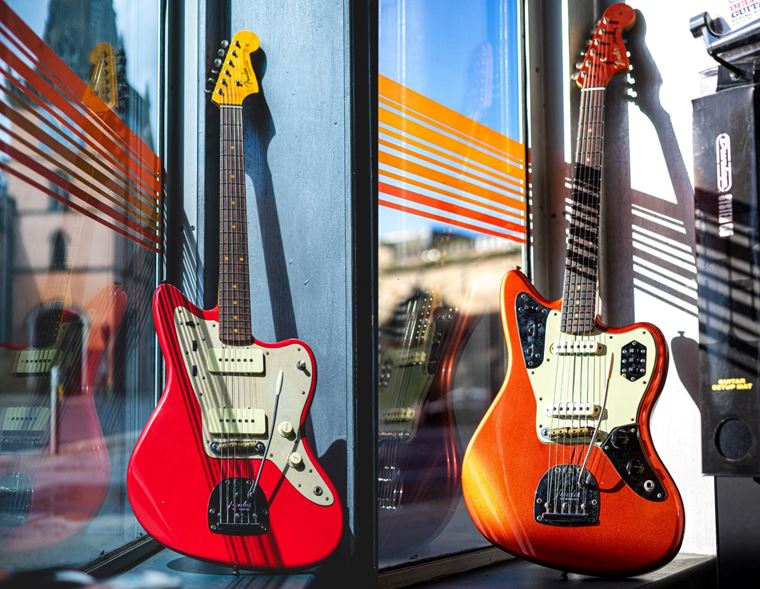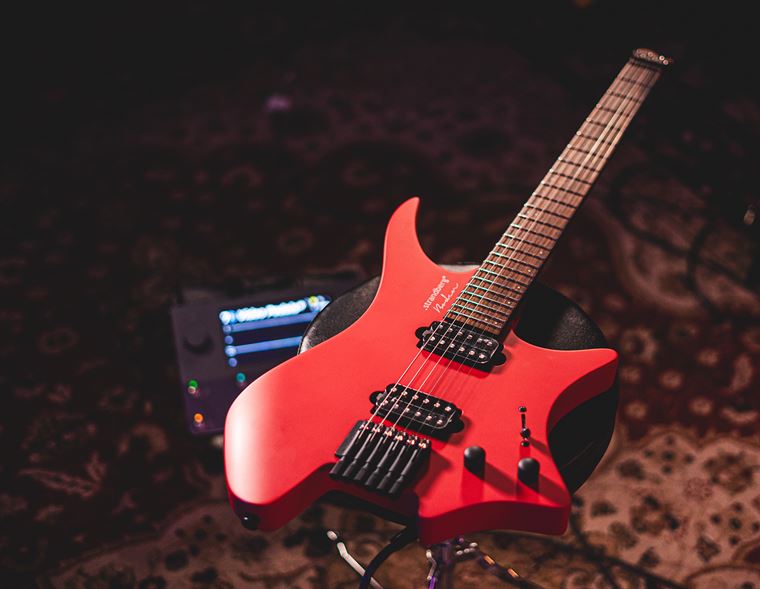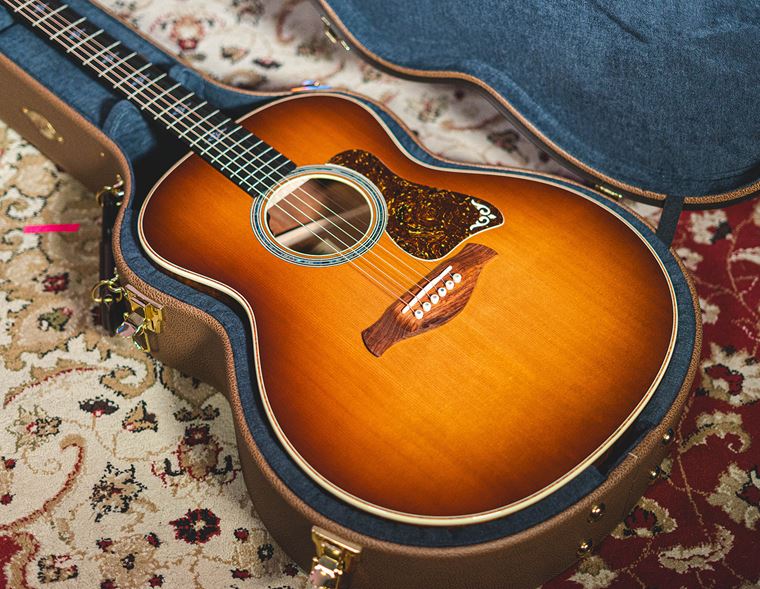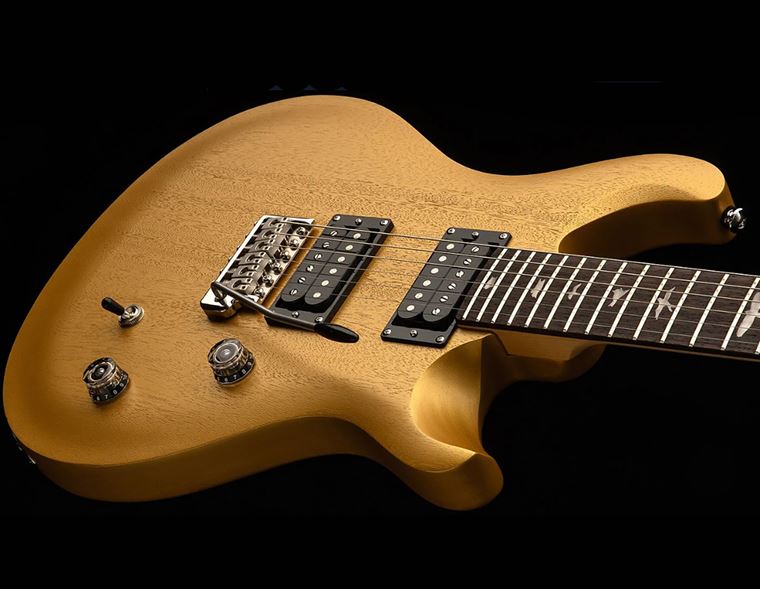Bursts: 2023 Guide to Les Paul Standard Sunburst Finishes
You are here because you love the Gibson Les Paul Standard. We expect you’ve clicked through here today to admire some gorgeous ‘bursts’, and we aim to give that to you! Now, the purpose of today’s drool-fest is actually to provide an easy reference point for all of the different burst finishes that Gibson currently offer on their Original Series Les Paul Standards. There are two overall models - a 50s and a 60s Les Paul - and each has their own selection of finishes. Today is all about seeing them in one place, so you can more easily understand which is which.
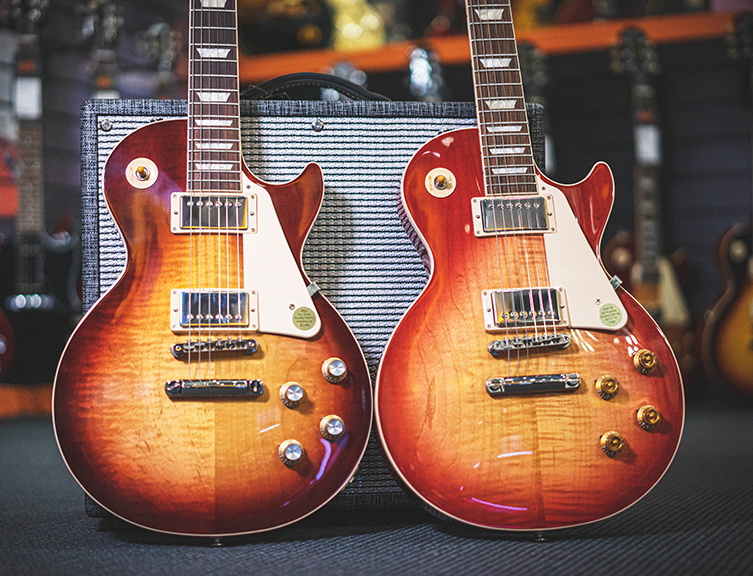
The Beauty of the Burst
As Gibson fans know, the Les Paul was introduced in 1952 with a solid metallic gold finish. Gibson still produce the most-excellent Goldtop in today’s Original Collection, but we’re looking at the Sunburst models, more or less based on what historically came in the 1958-60 period.
As you may or may not know, in 1960, Gibson actually stopped production of the Les Paul for 8 years. It was an expensive guitar to buy compared with Fenders, and didn’t have that surf-twang tone beloved by the world for that brief period. Sales fell and it got scrapped, as mad as that seems today.
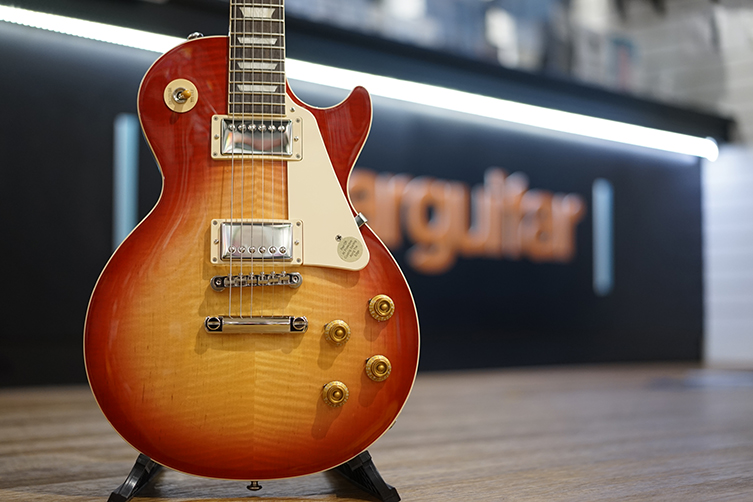
Anyway, the British Invasion and certain other factors brought the Les Paul back onto the world’s stages in 1968. Older burst guitars were being used by Page, Beck, Clapton etc (which are now considered some of the most valuable and lusted after instruments in existence) and so new burst-finish Les Paul guitars finally began to be created once again.
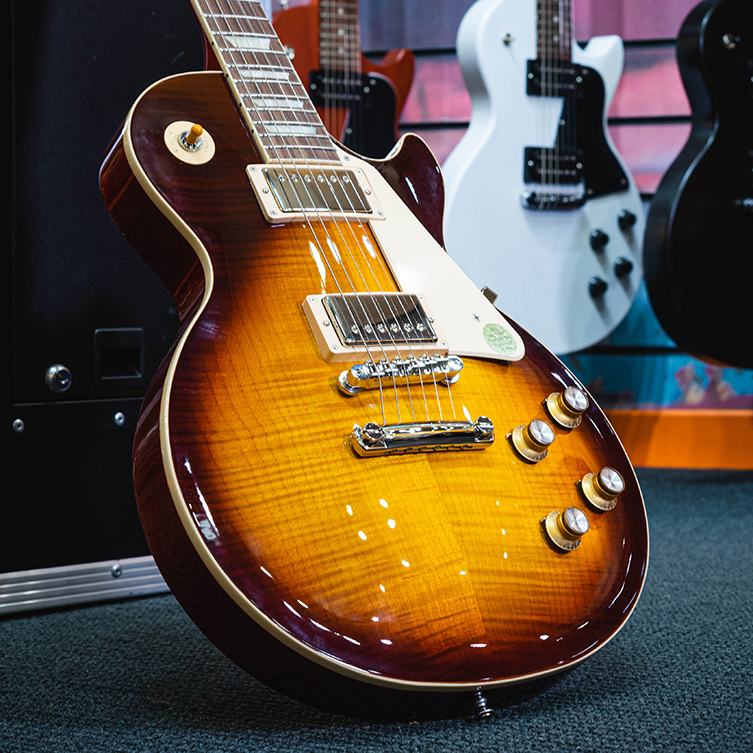
So it goes, and the guitar has been in constant production ever since. There have been countless variations of the Les Paul, but most guitar fans will instantly think of the sunburst Les Paul Standard when considering the model. As we mentioned, Gibson currently produce two varieties in their Original range (to distinguish from the Modern Series guitars which have non-vintage specs and features). We’ll take them each one at a time, and let the pictures speak for themselves. But first…
Why Are There Different Sunbursts?
Yes, why are there so many shades of Sunburst? Was this how things were in the 50s? Why don’t Gibson just make one?
All good questions! To answer them, we may need to slide into some Les Paul hearsay/mythology, but we’ll signpost this and stick to the facts (as they are) as much as possible.
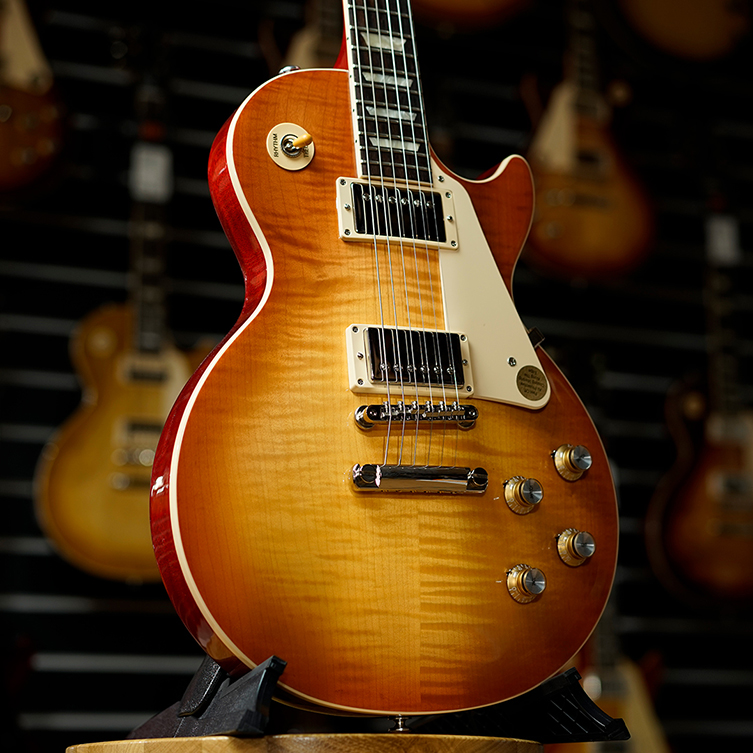
The Sunburst Les Pauls of the 1950s were offered simply as ‘Sunburst’. There were no official distinctions. In reality, only a few hundred were ever made between 1958-60, so it’s tough to attach authority to any overtly specific colour as being definitive, but the vast, vast majority were painted up like today’s Heritage Cherry Sunburst colour, which you’ll read about soon. This means a very rich, bright Cherry colour which transitions to Amber.
Okay. Variations did occur, though. Why? Well, because these were all hand sprayed (as they still are) and small differences in how the colours were mixed, and in how many coats were applied, meant that the finished articles often somewhat varied in terms of their final look.
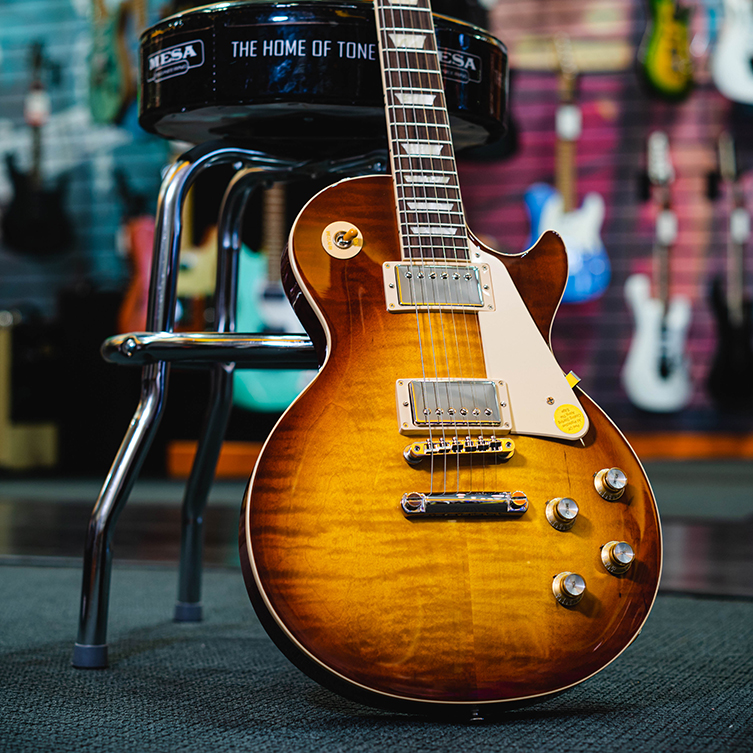
The darker-edged finishes came around, believe it or not, from pragmatic considerations. Some slices of maple destined for Les Paul tops looked mostly great, but had some physical ‘imperfections’ that spoiled their otherwise pleasing look. Instead of wasting good timber, the Gibson builders simply cut the tops in order to position these flecks and imperfections to the outer edges of the instrument’s face when building the guitar. When the time came to spray the colour coats, the Gibson artisans simply mixed up darker coats of reddish brown and added a coat or two on top of the already-applied Cherry coat. Since Gibson already used such bursts on their acoustic guitar models (and Les Paul Juniors), it wasn’t looked at as being an odd move.
Now, potential mythology here, but it’s fairly well reported that some Gibson employees just sprayed darker edges because they wanted to. Forums report that these folk ‘didn’t like Cherry Sunburst’, which would imply to us that they were in the wrong job, but you never know! Again, this may not be true, but there were not a lot of Les Pauls being made back then (because they were not selling well), so is it crazy to believe that some staff just tried a slightly different shade of burst to see if it made a difference? We don’t think that sounds crazy at all. In the 50s, how often would a musician even ever see a Les Paul in the flesh, let alone numerous ones to compare?
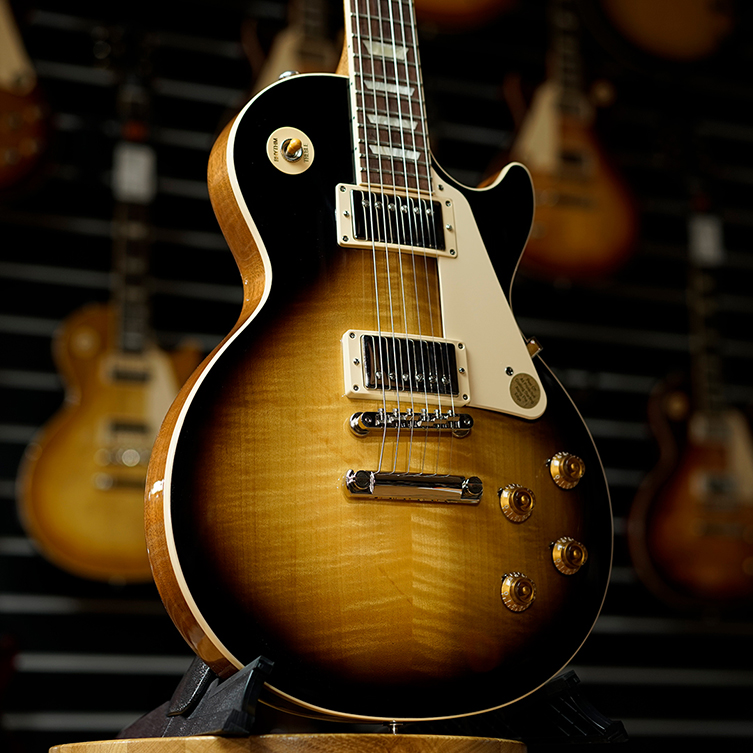
One factor that is essential to the answer of the number of bursts is the environment. These guitars were painted and finished with nitrocellulose, which reacts with (pretty much everything, to be honest) the sun and eventually fades. The Cherry part often faded the quickest, and an easy way to understand that is to look at pictures of Peter Green’s legendary ‘59 Les Paul Standard. Late 60s pics of Fleetwood Mac in action show the guitar as a ‘proper’ Sunburst. Compare those pics to how the guitar looks today in the hands of Kirk Hammett. No Cherry anywhere in sight, nor has there been for decades! It’s the same guitar, folks. People love the different phases and stages of fading on these Gibsons, so Gibson have just made it an easy thing to choose which stage you prefer!
Pick Your Top
Every slice of wood is different. Every piece of delicious figured maple that makes it on to a Gibson Les Paul Standard will have its own flaming, grain patterns and other distinguishing natural marks. This is what makes these guitars so beautifully interesting, because truly, no two are exactly alike.
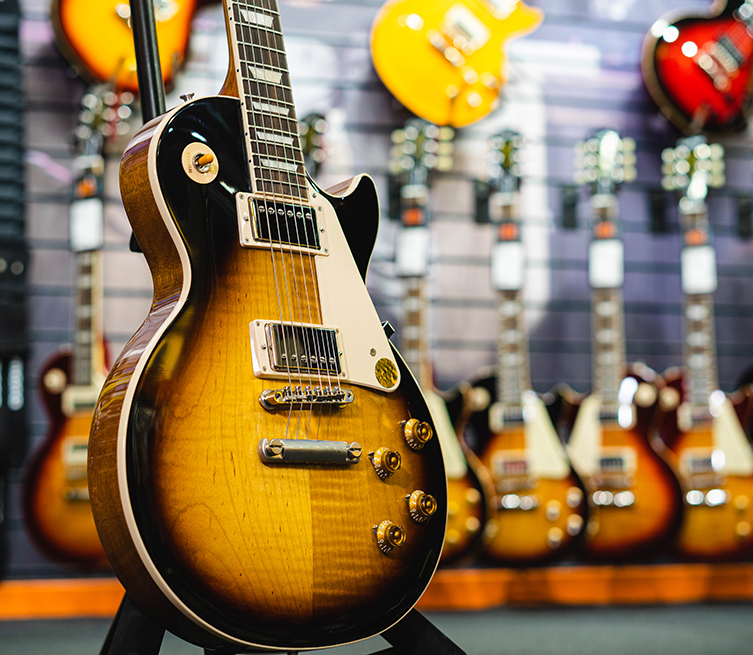
We are keenly aware of this at guitarguitar. How often have you gazed at a wonderful looking instrument on some retailer's website, only to find that the one you receive bears little resemblance? You base your decisions on what you see, and so, to that end, all of our Gibson Les Paul Standard guitars are individually listed. We do this because, when you see the one you love, we want you to have that exact guitar, not merely one example of its type. With solid colour finishes, this is less of an issue of course, but these bursts are as individual as you are, and we take the time to offer you the exact models we have in stock. We believe that makes a big difference.
It’s also worth reiterating the fact that these are all ‘regular’ Les Paul Standards. By that we mean that they aren’t Gibson Custom Shop models: they are the Nashville factory’s flagship, true blue Les Paul models: USA handmade quality but within reach of the serious player.
Heritage Cherry Sunburst
Beginning with the 50s model, there are two burst options. As mentioned, you can also get the goldtop (in both P90 and humbucker varieties, which is a great thing indeed) finish, but we’re focussing today on the bursts, so here are examples of Gibson Les Paul Standard 50s models, firstly in Heritage Cherry Sunburst.

Heritage Cherry Sunburst is the ‘hero’ colour for Les Pauls, if you like. It’s the shade that almost all fifties Les Pauls were initially sprayed with. This is, therefore, the equivalent to a factory fresh Les Paul from the late 50s with no loss of colour due to fading.
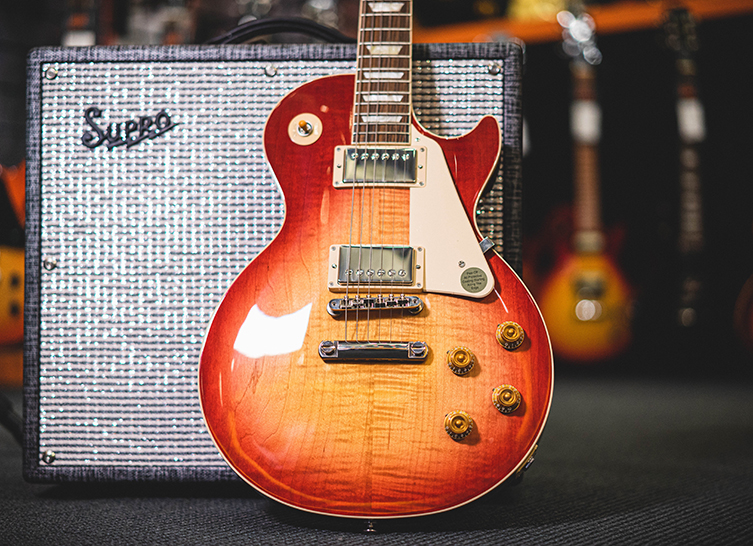
Tobacco Burst

The other 50s option is Tobacco Burst. This is similar to the rare examples you see of Les Pauls who had darker edges sprayed in to cover imperfect wood, as mentioned above. That’s not the case these days, by the way! It’s a legitimate option.
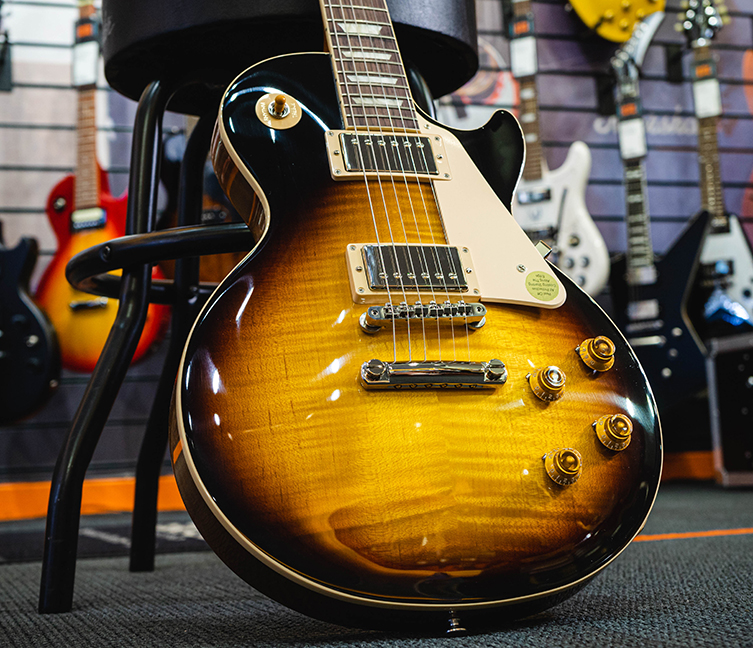
Most examples of Tobacco Burst today will use an edge tone so dark it reads as black, so there is a strong contrast there between the dark edges and the brighter amber of the centre.
Iced Tea

The first 60s model on display here is perhaps an equivalent to the brighter Heritage Cherry Sunburst of the 50s variant. Iced Tea, named after the Yankee beverage it is somewhat akin to is colour (but not really, let’s face it) is like a middle ground between the typical Sunburst and it’s darker-edged cousins: there’s still plenty of richness and contrast here, but everything is a shade less bright.
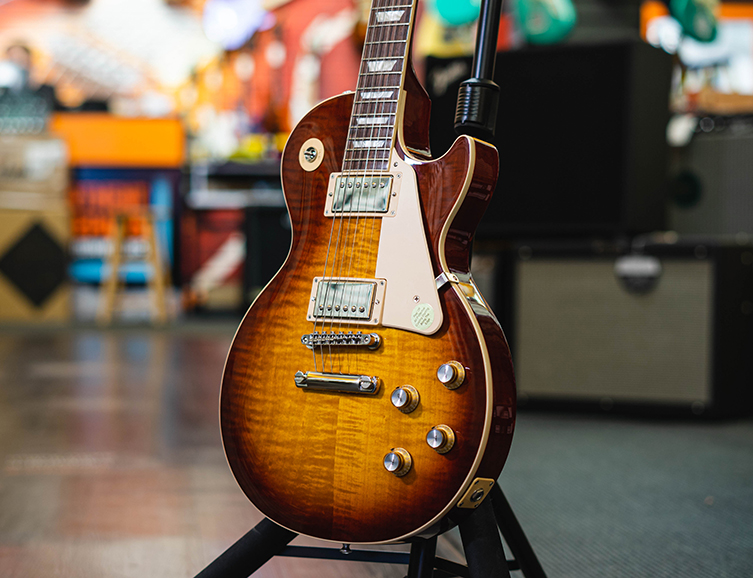
Iced Tea has certainly become a firm favourite with our customers over the last few years! Whether that’s more to do with the burst or a preference for the slightly thinner 60s neck is an unclear matter, but it’s a stunner either way!
Bourbon Burst

Bourbon Burst is the ‘darkburst’ equivalent to the Tobacco Burst of the 50s Standard. This model goes as far as brown at its edges, and retains a little more of the dark amber towards the centre.
It’s not as highly contrasting as the Tobacco Burst, but is very close to some of the late 50s examples included in Beauty of the Burst, a famous coffee table book which collects together all known surviving vintage 50s LP Sunbursts.
Unburst

The last of the 60s bursts is the archly-titled Unburst. This directly refers to the phenomenon we described earlier whereby the cherry of those early sunburst finishes would fade over time, leaving an array of ever more orange and amber hues instead.

Unburst is not trying to replicate ageing or fading: it’s simply a great burst colour that has taken inspiration from the natural look of a vintage Les Paul Standard. This is, in our opinion, one of the most gorgeous Les Paul finishes outside of the Custom Shop models, from a series of instruments that are uniformly stunning to look at.
The Les Paul Standard
So there you have it: that is each of the available bursts for the Les Paul Standard. Since every guitar is different, we recommend paying us a visit to view them all in the flesh: a picture can tell a thousand words, sure, but you aren’t able to get a feel for the neck (you may expect to prefer one and find you like the other etc), you can’t hear the different models, and you can’t see how the light reflects the stunning finishes unless you are there in person.
Gibson has a very long, storied history, as we know, and these current Les Paul Standards are everything you’d want a Les Paul to be. All you need to do is pick your favourite top!
Click to View our Selection of Gibson Les Paul Standards







